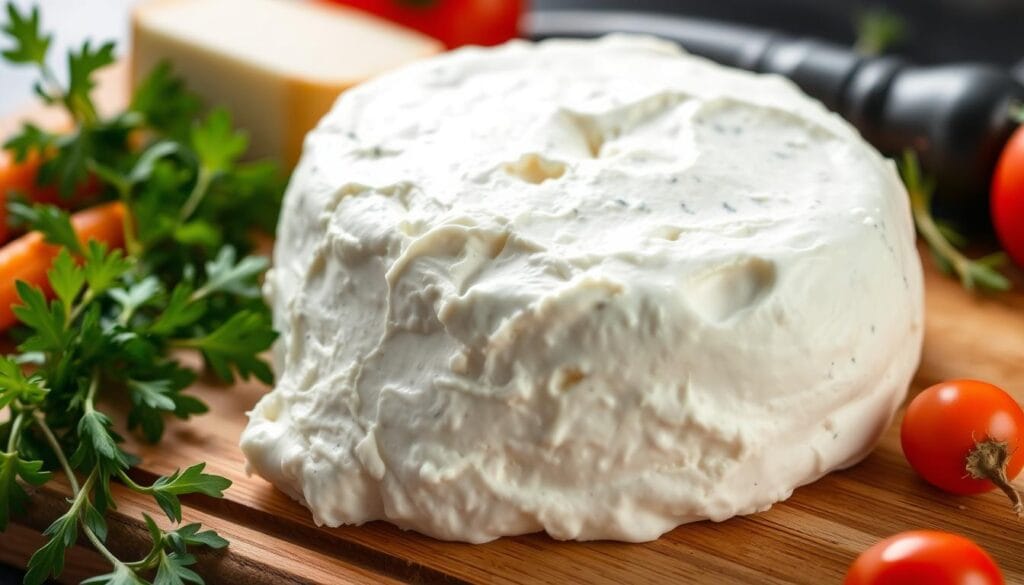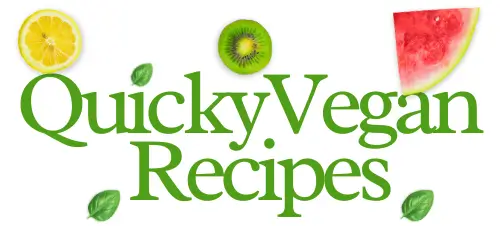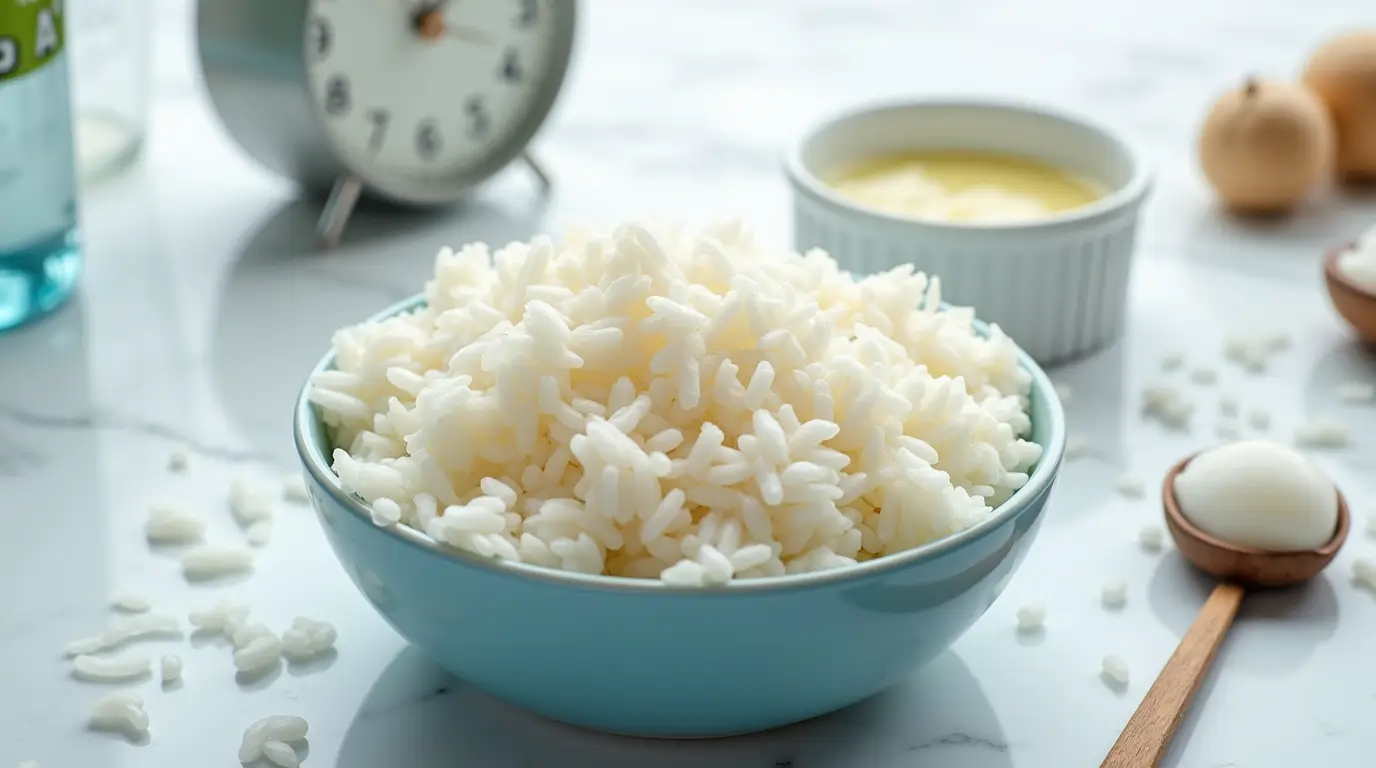As a mom of two young kids who can’t digest lactose, I’ve looked far and wide for dairy substitutes. I wanted something that tasted great and was as creamy as the real thing. That’s when I found lactose-free cream cheese, a real game-changer for our family.
If you’re like me and have had trouble finding dairy-free options that taste good, this guide is for you. Let’s dive into the world of lactose-free cream cheese. We’ll discover its benefits and see how it can make your cooking better, all while meeting your dietary needs.
Key Takeaways
- Lactose-free cream cheese is a dairy-free alternative to traditional cream cheese, made possible by the addition of the lactase enzyme.
- It offers a similar creamy texture and tangy flavor to regular cream cheese, making it a versatile ingredient in baking, spreads, and more.
- Lactose-free cream cheese is a great option for those with lactose intolerance, providing a delicious and digestible dairy-free solution.
- While it may cost slightly more than regular cream cheese, the benefits of improved digestibility and allergen-free convenience make it a worthwhile investment.
- Explore a variety of lactose-free cream cheese brands and find the one that best suits your taste preferences and culinary needs.
Understanding Lactose Free Cream Cheese Basics
Lactose free cream cheese is made for people who can’t digest regular cream cheese. It’s made differently to be easier to digest. This makes it great for those with dietary restrictions.
Key Ingredients and Production Methods
Lactose free cream cheese uses the same ingredients as regular cream cheese. These include milk, cream, and cultures. But, it also has lactase enzyme. This enzyme breaks down lactose, making it easier for those with lactose intolerance to eat.
How Lactase Enzyme Makes it Digestible
The lactase enzyme is key in making lactose free cream cheese. It breaks down lactose, which can cause stomach issues. This process lets people with lactose intolerance enjoy the cream cheese without discomfort.
Nutritional Profile Overview
| Nutrient | Lactose Free Cream Cheese | Regular Cream Cheese |
|---|---|---|
| Calories | 100 per 2 tbsp | 100 per 2 tbsp |
| Fat | 10g | 10g |
| Carbohydrates | 2g | 2g |
| Protein | 2g | 2g |
| Lactose | 0g | 2g |
The table shows lactose free cream cheese and regular cream cheese are similar. The main difference is lactose free cream cheese has no lactose. This makes it a good choice for those who can’t eat regular cream cheese.

Benefits of Choosing Lactose Free Cream Cheese
If you’re lactose intolerant or want to eat more plant-based, vegan cream cheese or allergen-free cream cheese is a great choice. These plant-based cream cheese options meet dietary needs and offer special benefits.
Choosing lactose free cream cheese helps those with lactose intolerance digest better. The lactase enzyme breaks down lactose, making it easier to eat for those who can’t handle dairy.
- Improved digestibility for lactose-intolerant individuals
- Potential health benefits associated with plant-based ingredients
- Versatility in various culinary applications, from baking to spreads and dips
Vegan cream cheese and allergen-free cream cheese also have health perks. They are made with natural, wholesome ingredients. This makes them a nutritious choice for many diets.
“Choosing lactose free cream cheese can be a game-changer for those with lactose intolerance, providing a delicious and digestible alternative to traditional dairy-based options.”
The versatility of lactose free cream cheese is unmatched. It’s perfect for baking, spreads, or dips. These plant-based cream cheese options add variety to your cooking, making meals more enjoyable and inclusive.

Different Types of Non-Dairy Cream Cheese Alternatives
Looking for a lactose-free or vegan cream cheese? The market has many options. You can find plant-based, nut-based, and soy-based alternatives. These choices meet different dietary needs and tastes, offering tasty and flexible substitutes.
Plant-Based Options Available
Coconut and cashew milk-free cream cheese products are popular. They are creamy and dairy-free. These alternatives have a texture and tangy flavor like traditional cream cheese. They work well in baking, spreads, and dips.
Nut-Based Varieties
Almond and macadamia nut vegan cream cheese options are also available. They offer a rich, creamy texture and a nutty flavor. This makes them great for both savory and sweet dishes.
Soy-Based Alternatives
Soy-based plant-based cream cheese is another option. It’s perfect for those with nut allergies or who prefer it. These alternatives aim to taste and spread like classic cream cheese. They’re good for many recipes.
“Exploring the diverse range of non-dairy cream cheese alternatives can open up a world of new culinary possibilities for those with lactose intolerance or vegan dietary needs.”
Taste and Texture Comparison with Regular Cream Cheese
Many people wonder how dairy-free cream cheese tastes and feels compared to regular cream cheese. The creamy, rich texture of traditional cream cheese is loved by many. But, the alternative cream cheese world has grown, offering specialty cream cheese that’s very similar.
The secret to lactose-free cream cheese is enzyme-based processing. This method makes it as smooth and spreadable as regular cream cheese. It’s also easy to digest for those who can’t handle lactose. Taste-wise, many dairy-free cream cheese options have the tangy, sweet flavor of traditional cream cheese. This is thanks to the right ingredients and special production ways.
“The texture of the lactose-free cream cheese is just as creamy and smooth as the regular kind, and the flavor is spot-on. I was pleasantly surprised by how well it holds up in baking and spreads beautifully on bagels.”
Everyone’s taste is different, so some might notice small differences in feel or flavor. But, the alternative cream cheese market keeps growing. It offers more choices for different tastes and diets. With a bit of trying, you’ll find a dairy-free cream cheese that you’ll love.
How to Use Lactose Free Cream Cheese in Recipes
Lactose free cream cheese is great for many recipes. It’s perfect for baking, making spreads and dips, or cooking. It’s a good substitute for regular cream cheese. Let’s see how to use it in your cooking.
Baking Applications
Lactose free cream cheese adds a creamy texture and rich flavor to baked goods. Use it for lactose free cheesecake, lactose free cream cheese frosting, or lactose free cream cheese-filled pastries. Just swap it for regular cream cheese in your recipes.
Spreads and Dips
Lactose free cream cheese is great for making tasty spreads and dips. Try making lactose free spinach and artichoke dip, lactose free cream cheese-based fruit spreads, or lactose free cream cheese-based veggie dips. It’s perfect for lactose-free appetizers and snacks.
Cooking Tips and Tricks
- When substituting lactose free cream cheese for regular cream cheese, use a 1:1 ratio in recipes.
- For best results, allow the lactose free cream cheese to come to room temperature before using it in your recipes.
- Be mindful of the texture and consistency of the lactose free cream cheese when compared to regular cream cheese, and adjust other ingredients as needed.
- Experiment with different non-dairy cream cheese brands to find the one that best suits your preferences and recipes.
By following these tips, you can easily add lactose free cream cheese to your cooking and baking. This way, you can make delicious and dairy-free dishes for everyone to enjoy.
Popular Brands and Market Options
The market is full of lactose-intolerant cream cheese options for different diets. You can find everything from well-known brands to new ones. This means you have more choices for your cooking.
Daiya is a big name in lactose-intolerant cream cheese. They make plant-based and dairy-free cream cheese. Their product is a mix of coconut oil and special ingredients, giving it a creamy feel like regular cream cheese.
Treeline is another favorite for nut-based alternative cream cheese. They use cashews to make their cream cheese. It’s rich and creamy, without the lactose that bothers some people.
| Brand | Key Features | Flavor Varieties | Availability |
|---|---|---|---|
| Daiya | Plant-based, dairy-free, made with coconut oil | Original, Chive & Onion, Strawberry | Wide availability in grocery stores and online |
| Treeline | Nut-based, cashew-derived, lactose-free | Plain, Herb, Scallion, Chipotle | Found in natural food stores and select supermarkets |
| Miyoko’s | Artisanal, plant-based, organic, non-GMO | Classic Plain, Chive, Smoked | Available in specialty and health food stores |
Other brands like Miyoko’s and Follow Your Heart are also worth checking out. Miyoko’s is known for its artisanal cream cheese, while Follow Your Heart offers soy-based options. As more people look for alternative cream cheese, we’ll see even more choices.
Storage Tips and Shelf Life
Keeping your lactose free cream cheese, dairy-free cream cheese, or plant-based cream cheese fresh is key. Follow storage tips to keep it fresh longer. This way, you’ll enjoy your purchase to the fullest.
Proper Storage Methods
Always keep your cream cheese in the fridge. Store it in the coldest part of the fridge, like the back shelves. Don’t put it in the door, as it can get too warm.
Use the original packaging or a tight container to keep it fresh. Once opened, use it within the recommended time for the best taste.
Signs of Spoilage
Lactose free cream cheese, dairy-free cream cheese, and plant-based cream cheese can spoil if not stored right. Watch for these signs:
- Discoloration or changes in texture, such as mold growth or a slimy appearance
- Unpleasant or sour odor
- Expired “use by” date
If you see these signs, throw it away to stay safe. Proper storage and handling are crucial for enjoying your cream cheese.
Health Considerations and Dietary Restrictions
Looking for allergen-free cream cheese and lactose-intolerant cream cheese? You’re in luck. Lactose free cream cheese is perfect for those with dietary restrictions. It doesn’t have lactose from milk, unlike regular cream cheese.
Lactose free cream cheese is great for many diets. It works well for vegans, vegetarians, and those who follow a gluten-free diet. Some types are even free from nuts or soy, making them safe for people with multiple food allergies.
The nutritional value of lactose free cream cheese is close to regular cream cheese. It has similar calories and fat. But, always check the labels to make sure it fits your health goals and preferences.
FAQ
What is lactose free cream cheese and how does it compare to regular cream cheese?
Lactose free cream cheese is a special type of dairy product. It has less or no lactose, the sugar in milk. It’s made for people who can’t digest lactose or prefer to avoid it.
It tastes and feels like regular cream cheese but is easier to digest. This makes it great for those with lactose issues.
What are the key ingredients and production methods used in lactose free cream cheese?
Lactose free cream cheese is made with milk, cream, and cultures, just like regular cream cheese. But, it also has lactase enzyme. This enzyme breaks down lactose into simpler sugars.
This process makes the lactose content very low or undetectable. This is key for those who can’t digest lactose well.
How does the lactase enzyme make lactose free cream cheese more digestible?
The lactase enzyme breaks down lactose into glucose and galactose. These are easier for the body to absorb. This makes lactose free cream cheese better for those with lactose intolerance.
What is the nutritional profile of lactose free cream cheese compared to regular cream cheese?
Lactose free cream cheese is similar to regular cream cheese in nutrition. Both are high in fat and calories. They have similar amounts of protein too.
The main difference is the lactose content. Lactose free cream cheese has less or no lactose, making it better for those with lactose issues.
What are the benefits of choosing lactose free cream cheese?
Choosing lactose free cream cheese helps those with lactose intolerance or sensitivity. It lets them enjoy cream cheese without digestive problems.
It’s also good for those on special diets or with dietary restrictions. Lactose free cream cheese can offer health benefits too.
What are the different types of non-dairy cream cheese alternatives available?
There are many non-dairy cream cheese alternatives. These include plant-based, nut-based, and soy-based options. Plant-based ones are made from cashews, almonds, or coconut.
Soy-based alternatives use soy as the main ingredient. These options are great for vegans, those on dairy-free diets, and people with allergies.
How does the taste and texture of lactose free cream cheese compare to regular cream cheese?
Lactose free cream cheese tastes and feels like regular cream cheese. It has a similar creamy and spreadable texture. The flavor is also close, with a tangy and slightly sweet taste.
How can I use lactose free cream cheese in recipes?
You can use lactose free cream cheese in many recipes, just like regular cream cheese. It’s great in baked goods, as a spread, or dip.
When substituting, use the same amount and cooking methods. You might need to adjust baking times or temperatures a bit.
What are some popular brands and market options for lactose free cream cheese?
Well-known brands like Tofutti, Daiya, and Kite Hill offer lactose free cream cheese. They have different flavors and varieties, like plain and chive.
Many dairy brands also have lactose free options. This is to meet the growing demand for lactose-free alternatives.
How should I store lactose free cream cheese and what is its shelf life?
Store lactose free cream cheese in the fridge, between 35°F and 40°F. Keep it in its original packaging or an airtight container to stay fresh.
Most products last 2-3 weeks when stored right. Look out for signs of spoilage like color changes, bad smells, or texture changes.
Are there any health considerations or dietary restrictions to be aware of with lactose free cream cheese?
Lactose free cream cheese is good for those with lactose intolerance or on lactose-free diets. But, always check the ingredients and nutrition info.
Some lactose free options might have allergens like nuts or soy. Always talk to a healthcare professional or nutritionist to make sure it’s right for you.
perfect
5 stars







